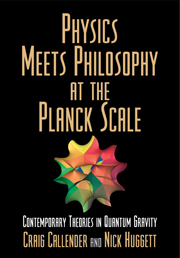Book contents
- Frontmatter
- Contents
- Preface
- 1 Introduction
- Part I Theories of Quantum Gravity and their Philosophical Dimensions
- Part II Strings
- Part III Topological Quantum Field Theory
- Part IV Quantum Gravity and the Interpretation of General Relativity
- 9 On general covariance and best matching
- 10 Pre-Socratic quantum gravity
- 11 The origin of the spacetime metric: Bell's ‘Lorentzian pedagogy’ and its significance in general relativity
- Part V Quantum Gravity and the Interpretation of Quantum Mechanics
- References
- Notes on contributors
- Index
11 - The origin of the spacetime metric: Bell's ‘Lorentzian pedagogy’ and its significance in general relativity
Published online by Cambridge University Press: 15 December 2009
- Frontmatter
- Contents
- Preface
- 1 Introduction
- Part I Theories of Quantum Gravity and their Philosophical Dimensions
- Part II Strings
- Part III Topological Quantum Field Theory
- Part IV Quantum Gravity and the Interpretation of General Relativity
- 9 On general covariance and best matching
- 10 Pre-Socratic quantum gravity
- 11 The origin of the spacetime metric: Bell's ‘Lorentzian pedagogy’ and its significance in general relativity
- Part V Quantum Gravity and the Interpretation of Quantum Mechanics
- References
- Notes on contributors
- Index
Summary
Introduction
In 1976, J.S. Bell published a paper on ‘How to teach special relativity’ (Bell 1976). The paper was reprinted a decade later in his well-known book Speakable and unspeakable in quantum mechanics – the only essay to stray significantly from the theme of the title of the book. In the paper Bell was at pains to defend a dynamical treatment of length contraction and time dilation, following ‘very much the approach of H.A. Lorentz’ (Bell 1987, p. 77).
Just how closely Bell stuck to Lorentz's thinking in this connection is debatable. We shall return to this question shortly. In the meantime, we briefly rehearse the central points of Bell's rather unorthodox argument.
Bell considered a single atom modelled by an electron circling a more massive nucleus, ignoring the back-effect of the field of the electron on the nucleus. The question he posed was: what is the prediction in Maxwell's electrodynamics (taken to be valid in the frame relative to which the nucleus is initially at rest) as to the effect on the electron orbit when the nucleus is set (gently) in motion in the plane of the orbit? Using only Maxwell's field equations, the Lorentz force law and the relativistic formula linking the electron's momentum and its velocity – which Bell attributed to Lorentz – he concluded that the orbit undergoes the familiar longitudinal (‘Fitzgerald’ (sic)) contraction, and its period changes by the familiar (‘Larmor’) dilation.
- Type
- Chapter
- Information
- Physics Meets Philosophy at the Planck ScaleContemporary Theories in Quantum Gravity, pp. 256 - 272Publisher: Cambridge University PressPrint publication year: 2001
- 25
- Cited by

